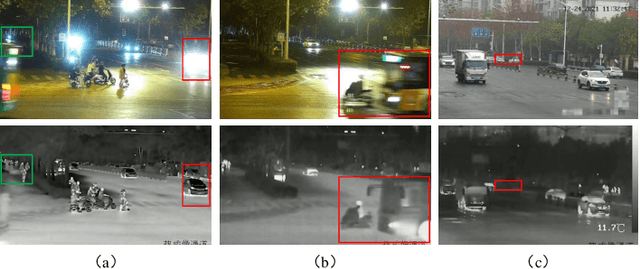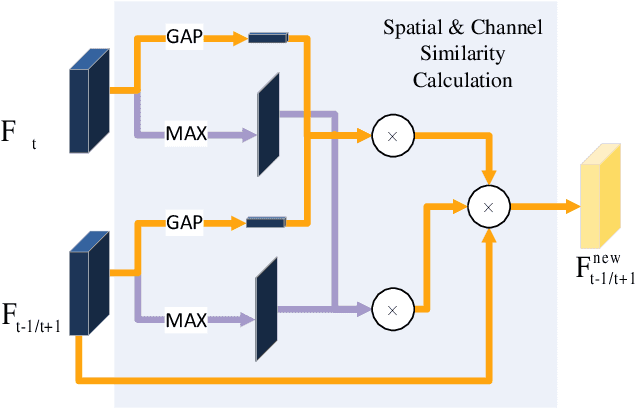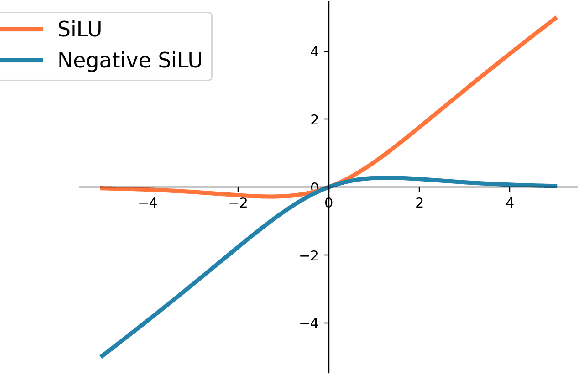Qishun Wang
Multimodal Spatio-temporal Graph Learning for Alignment-free RGBT Video Object Detection
Apr 16, 2025Abstract:RGB-Thermal Video Object Detection (RGBT VOD) can address the limitation of traditional RGB-based VOD in challenging lighting conditions, making it more practical and effective in many applications. However, similar to most RGBT fusion tasks, it still mainly relies on manually aligned multimodal image pairs. In this paper, we propose a novel Multimodal Spatio-temporal Graph learning Network (MSGNet) for alignment-free RGBT VOD problem by leveraging the robust graph representation learning model. Specifically, we first design an Adaptive Partitioning Layer (APL) to estimate the corresponding regions of the Thermal image within the RGB image (high-resolution), achieving a preliminary inexact alignment. Then, we introduce the Spatial Sparse Graph Learning Module (S-SGLM) which employs a sparse information passing mechanism on the estimated inexact alignment to achieve reliable information interaction between different modalities. Moreover, to fully exploit the temporal cues for RGBT VOD problem, we introduce Hybrid Structured Temporal Modeling (HSTM), which involves a Temporal Sparse Graph Learning Module (T-SGLM) and Temporal Star Block (TSB). T-SGLM aims to filter out some redundant information between adjacent frames by employing the sparse aggregation mechanism on the temporal graph. Meanwhile, TSB is dedicated to achieving the complementary learning of local spatial relationships. Extensive comparative experiments conducted on both the aligned dataset VT-VOD50 and the unaligned dataset UVT-VOD2024 demonstrate the effectiveness and superiority of our proposed method. Our project will be made available on our website for free public access.
Unveiling the Limits of Alignment: Multi-modal Dynamic Local Fusion Network and A Benchmark for Unaligned RGBT Video Object Detection
Oct 16, 2024



Abstract:Current RGB-Thermal Video Object Detection (RGBT VOD) methods still depend on manually aligning data at the image level, which hampers its practical application in real-world scenarios since image pairs captured by multispectral sensors often differ in both fields of view and resolution. To address this limitation, we propose a Multi-modal Dynamic Local fusion Network (MDLNet) designed to handle unaligned RGBT image pairs. Specifically, our proposed Multi-modal Dynamic Local Fusion (MDLF) module includes a set of predefined boxes, each enhanced with random Gaussian noise to generate a dynamic box. Each box selects a local region from the original high-resolution RGB image. This region is then fused with the corresponding information from another modality and reinserted into the RGB. This method adapts to various data alignment scenarios by interacting with local features across different ranges. Simultaneously, we introduce a Cascaded Temporal Scrambler (CTS) within an end-to-end architecture. This module leverages consistent spatiotemporal information from consecutive frames to enhance the representation capability of the current frame while maintaining network efficiency. We have curated an open dataset called UVT-VOD2024 for unaligned RGBT VOD. It consists of 30,494 pairs of unaligned RGBT images captured directly from a multispectral camera. We conduct a comprehensive evaluation and comparison with MDLNet and state-of-the-art (SOTA) models, demonstrating the superior effectiveness of MDLNet. We will release our code and UVT-VOD2024 to the public for further research.
A Spatial-Temporal Progressive Fusion Network for Breast Lesion Segmentation in Ultrasound Videos
Mar 18, 2024Abstract:Ultrasound video-based breast lesion segmentation provides a valuable assistance in early breast lesion detection and treatment. However, existing works mainly focus on lesion segmentation based on ultrasound breast images which usually can not be adapted well to obtain desirable results on ultrasound videos. The main challenge for ultrasound video-based breast lesion segmentation is how to exploit the lesion cues of both intra-frame and inter-frame simultaneously. To address this problem, we propose a novel Spatial-Temporal Progressive Fusion Network (STPFNet) for video based breast lesion segmentation problem. The main aspects of the proposed STPFNet are threefold. First, we propose to adopt a unified network architecture to capture both spatial dependences within each ultrasound frame and temporal correlations between different frames together for ultrasound data representation. Second, we propose a new fusion module, termed Multi-Scale Feature Fusion (MSFF), to fuse spatial and temporal cues together for lesion detection. MSFF can help to determine the boundary contour of lesion region to overcome the issue of lesion boundary blurring. Third, we propose to exploit the segmentation result of previous frame as the prior knowledge to suppress the noisy background and learn more robust representation. In particular, we introduce a new publicly available ultrasound video breast lesion segmentation dataset, termed UVBLS200, which is specifically dedicated to breast lesion segmentation. It contains 200 videos, including 80 videos of benign lesions and 120 videos of malignant lesions. Experiments on the proposed dataset demonstrate that the proposed STPFNet achieves better breast lesion detection performance than state-of-the-art methods.
Erasure-based Interaction Network for RGBT Video Object Detection and A Unified Benchmark
Aug 03, 2023



Abstract:Recently, many breakthroughs are made in the field of Video Object Detection (VOD), but the performance is still limited due to the imaging limitations of RGB sensors in adverse illumination conditions. To alleviate this issue, this work introduces a new computer vision task called RGB-thermal (RGBT) VOD by introducing the thermal modality that is insensitive to adverse illumination conditions. To promote the research and development of RGBT VOD, we design a novel Erasure-based Interaction Network (EINet) and establish a comprehensive benchmark dataset (VT-VOD50) for this task. Traditional VOD methods often leverage temporal information by using many auxiliary frames, and thus have large computational burden. Considering that thermal images exhibit less noise than RGB ones, we develop a negative activation function that is used to erase the noise of RGB features with the help of thermal image features. Furthermore, with the benefits from thermal images, we rely only on a small temporal window to model the spatio-temporal information to greatly improve efficiency while maintaining detection accuracy. VT-VOD50 dataset consists of 50 pairs of challenging RGBT video sequences with complex backgrounds, various objects and different illuminations, which are collected in real traffic scenarios. Extensive experiments on VT-VOD50 dataset demonstrate the effectiveness and efficiency of our proposed method against existing mainstream VOD methods. The code of EINet and the dataset will be released to the public for free academic usage.
 Add to Chrome
Add to Chrome Add to Firefox
Add to Firefox Add to Edge
Add to Edge